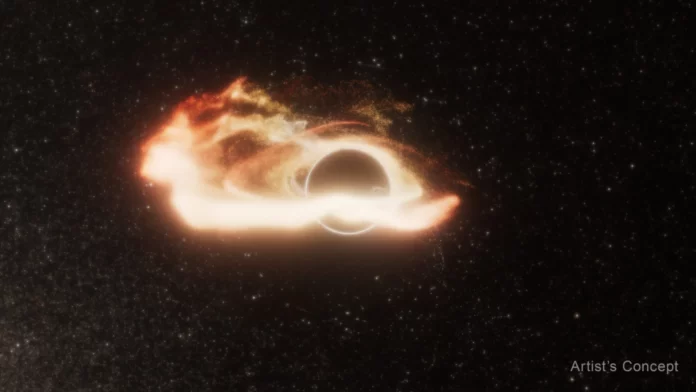Astronomers have spotted a supermassive black hole snacking on a star 600 million light-years away, wandering through a galaxy with an even bigger black hole at its core.
The event, dubbed AT2024tvd, was first detected by the Palomar Observatory’s Zwicky Transitioner and later confirmed by the most powerful space telescopes, including Hubble and Chandra, which helped pinpoint the exact location of the cosmic crime. To the surprise of the researchers, the responsible black hole was not located in the center of its galaxy, as is usually the case with supermassive black holes. Instead, it was 2600 light-years away from the center of the galaxy – a huge distance on paper, but in reality only one-tenth the distance between our Sun and Sagittarius A*, the black hole at the center of the Milky Way.
Tidal explosions like this one occur when the black hole’s gravity pulls on a star so hard that a less massive ball of gas is stretched, crushed, and swirled around the black hole – a process affectionately called spaghettification. The short-term burst of energy from this event is gigantic, even rivaling the brightness of a supernova, the explosive death of a massive star. The burst of light is also visible across the entire electromagnetic spectrum, making the TDE an invaluable resource for detecting black holes that might otherwise be too quiet or hidden to be detected, such as the recent rogue object.
What makes AT2024tvd special is that it is the first displaced TDE to be detected using optical observations, according to a forthcoming paper in The Astrophysical Journal Letters, which is also posted on the arXiv preprint server. This achievement demonstrates how rogue black holes, which bend space-time and are shrouded in darkness as they move through space, can be detected if the unfortunate object sacrifices itself so that the massive object can detect itself.
“Tidal disturbances hold great promise for illuminating the presence of massive black holes that we would otherwise not be able to detect,” said study co-author Ryan Chernock, a researcher at the University of California, Berkeley and a member of the ZTF team, in a NASA release. “Theorists have predicted that a population of massive black holes located far from the centers of galaxies should exist, but now we can use TDE to find them.”

The team has several ideas about how the rogue black hole came to be displaced in the galaxy and so close to the supermassive black hole at its core. (The mass of the rogue black hole is estimated to be about one million solar masses, which is at least ten times less than the mass of the black hole at the center of the galaxy.) One possibility is that the black hole was at the center of a smaller galaxy that was absorbed by a larger galaxy, and now the black hole is simply drifting through the larger galaxy. Another possibility is that the black hole was the weakest link in what was once a three-body system and was pushed out by the larger objects; in other words, two larger black holes could be hiding in the core of the galaxy, and the rogue black hole was ejected thousands of light-years away.
“If a black hole has gone through a triple interaction with two other black holes in the galaxy’s core, it may still be connected to the galaxy by orbiting the central region,” said Yuhan Yao, also a researcher at the University of California, Berkeley and lead author of the study, in the same release. But at this point, the team is not sure if the black hole was pushed out or if it is being pulled in by a larger black hole.
With upcoming instruments like the Vera Rubin Observatory and the Rome Space Telescope coming online, astronomers hope this is just the beginning of a whole new class of discoveries. Because if there’s anything more disturbing than a black hole swallowing a star, it’s the idea that hungry, starving objects are just drifting through space in unexpected places.









